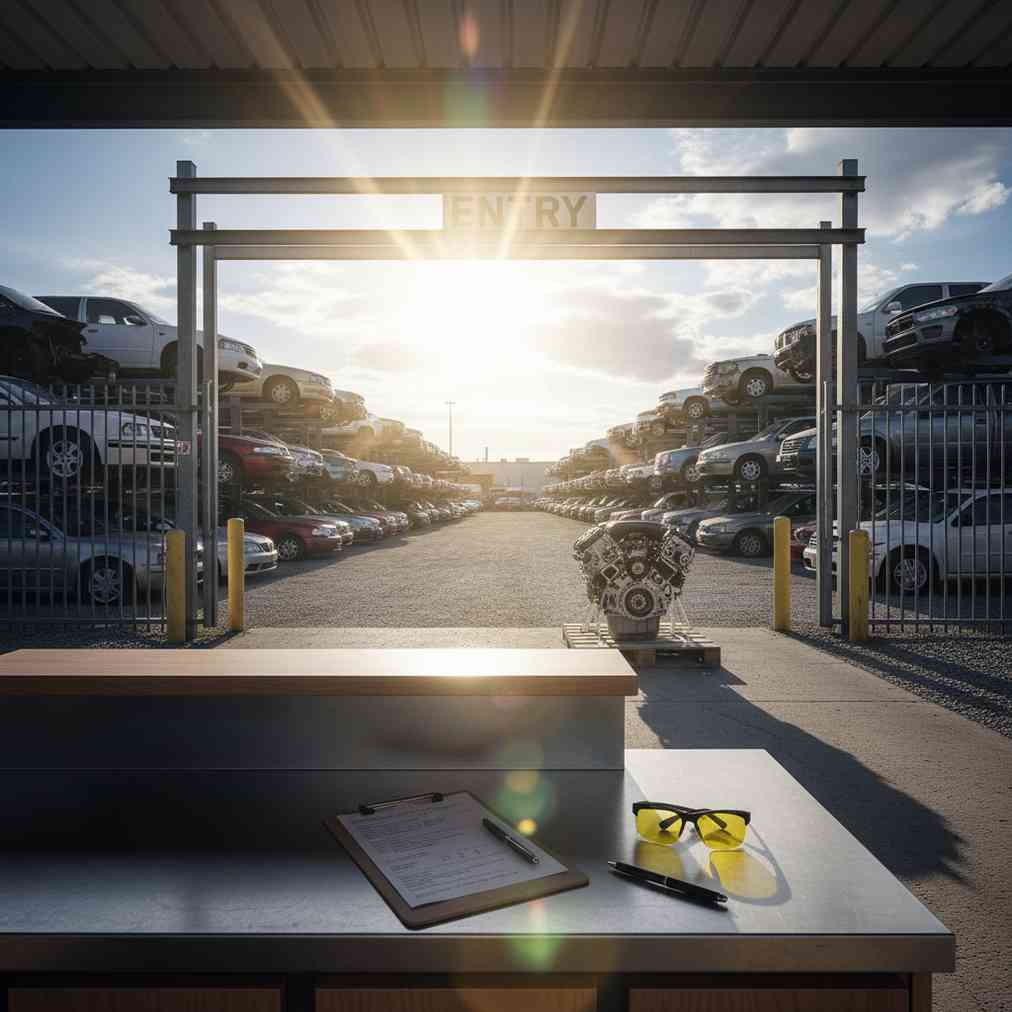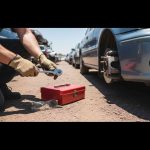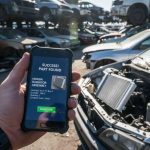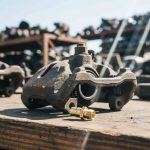Understanding the U-Pull-It Self-Service Experience
The self-service auto salvage yard experience, commonly known as U-Pull-It or Pick-and-Pull yards, offers an affordable way to acquire used auto parts while putting the work in your own hands. This comprehensive guide walks you through every step of the process, from preparation to checkout, ensuring you get the most value from your salvage yard visit.
Whether you’re a seasoned DIY mechanic or visiting a junkyard near me for the first time, understanding the complete process helps you save time, money, and avoid common mistakes that can turn a simple parts run into a frustrating experience.
Pre-Visit Preparation: Setting Yourself Up for Success
Research Your Parts and Vehicle Compatibility
Before heading to the yard, thorough preparation can save you hours of searching and ensure you find the right parts. Identify your exact vehicle specifications including year, make, model, and engine size to ensure compatibility with donor vehicles.
- Check the yard’s online inventory system if available
- Research part removal procedures using factory service manuals
- Create a checklist of compatible vehicle models
- Verify part numbers and specifications
- Compare salvage yard prices with new parts to ensure value
Essential Tools and Safety Equipment
Most salvage yards operate on a bring-your-own-tools policy, so come prepared with the right equipment for safe and efficient part removal.
| Tool Category | Essential Items | Safety Notes |
|---|---|---|
| Hand Tools | Socket sets (metric/SAE), screwdrivers, pliers, adjustable wrenches | Avoid power tools – often prohibited |
| Safety Gear | Work boots, safety glasses, work gloves | Closed-toe shoes required |
| Additional Items | Flashlight, penetrating oil, plastic bags for hardware | Some yards provide wheelbarrows |
The Check-In Process: Your Entry to the Yard
Upon arrival at the salvage yard, you’ll go through a standardized check-in process designed to ensure safety and legal compliance. Understanding what to expect streamlines your entry and gets you searching for parts faster.
Documentation and Liability Requirements
- Sign the liability waiver – This is mandatory at all reputable yards
- Present valid identification when requested
- Pay the entrance fee (typically $1-$5, non-refundable)
- Undergo tool inspection if required by yard policy
- Receive yard map or vehicle location assistance
“The key to a successful salvage yard visit is preparation: check online inventory, bring the right tools, and plan your search. Always ask for a map if it’s your first time—it can save hours.”
—Ace Auto Parts
Understanding Yard Organization and Layout
Most professional salvage yards organize their inventory systematically to help customers locate vehicles efficiently. Yard layouts typically follow one of these organizational methods:
- By manufacturer – Ford, Chevrolet, Toyota sections
- By vehicle type – Cars, trucks, SUVs separated
- By popularity/demand – High-demand models in accessible areas
- By arrival date – Newer acquisitions in designated zones
Locating and Removing Parts: The Hands-On Phase
Once you’ve located the appropriate donor vehicle, the real work begins. Successful part removal requires patience, the right technique, and respect for other customers who may need adjacent parts.
Inspection and Assessment Protocol
Before removing any part, conduct a thorough inspection to avoid wasting time on damaged or incompatible items. This step is crucial since most sales are final.
- Check for physical damage, rust, or excessive wear
- Verify part numbers and compatibility markings
- Test electrical parts if possible (bring a multimeter)
- Examine mounting points and connection integrity
- Take photos for reference during installation
If you’re looking for specific parts like OEM car parts or need guidance on when to buy used auto parts, our detailed guides provide valuable insights for making informed decisions.
Safe Removal Techniques
Professional part removal protects both you and the parts you’re acquiring. Follow these best practices for safe and efficient removal:
| Part Type | Removal Strategy | Special Considerations |
|---|---|---|
| Body Parts | Remove fasteners systematically, support weight | Check for hidden clips or adhesives |
| Engine Parts | Drain fluids first, label connections | Bring containers for fluids |
| Electrical Parts | Disconnect battery, cut wires cleanly | Leave enough wire for connections |
| Suspension Parts | Support vehicle properly, use penetrating oil | Never work under jack-only support |
Payment Process and Checkout Procedures
After successfully removing your desired parts, the checkout process determines your final cost and completes the transaction. Understanding pricing structures and payment policies helps avoid surprises at the counter.
Understanding Pricing Models
Most salvage yards use standardized pricing boards that list common parts and their fixed prices. This transparent system allows customers to know costs upfront and budget accordingly.
- Fixed pricing – Posted prices for common parts (alternators, starters, etc.)
- Weight-based pricing – Charged per pound for metal parts
- Vehicle-specific pricing – Higher prices for luxury or rare vehicle parts
- Bulk discounts – Reduced rates for multiple parts from same vehicle
Accepted Payment Methods and Policies
Modern salvage yards typically accept multiple payment methods, though policies vary by location. Cash remains king at most yards, but card payments are increasingly common.
- Accepted: Cash, debit cards, major credit cards (Visa, MasterCard, Discover)
- Usually not accepted: Personal checks, payment apps, financing
- Keep receipts: Required for warranty claims or returns
- Sales tax: Applied according to local regulations
If you’re considering selling your junk car instead of buying parts, many yards also purchase vehicles and can provide instant quotes for your unwanted vehicle.
Exit Process and Post-Purchase Considerations
The final phase of your salvage yard visit involves completing your exit and understanding your warranty rights and return policies. Proper documentation and understanding policies protect your investment.
Receipt Verification and Exit Procedures
- Present receipt to gate staff for verification
- Allow inspection of parts against receipt if requested
- Double-check for personal tools and belongings
- Secure parts properly for transport
- Note any yard-specific return policies
Warranty and Return Policies
While most used parts are sold “as-is,” many reputable yards offer limited warranty programs that provide some protection against defective parts.
| Policy Type | Typical Terms | Requirements |
|---|---|---|
| Exchange Program | 30-day exchange for store credit | Original receipt, part in similar condition |
| Testing Period | 48-72 hours for electrical parts | Professional testing documentation |
| No Returns | All sales final | Inspect thoroughly before purchase |
Key Statistics and Market Insights
The salvage yard industry processes approximately 5 million totaled vehicles annually in the United States, creating a massive inventory of available parts for consumers and repair shops.
- Cost savings: Self-service yards offer parts at 50-80% below retail prices
- Time efficiency: Prepared customers spend 50% less time searching
- Environmental impact: Auto recycling saves 85 million barrels of oil annually
- Customer satisfaction: 85% of customers return for future purchases when properly prepared
Recent Industry Developments and Technology Integration
The salvage yard industry continues evolving with technological innovations that improve customer experience and operational efficiency.
Digital Transformation Trends
- Online inventory systems – Real-time part availability checking
- Mobile applications – Dedicated apps for inventory lookup and navigation
- Digital payment integration – Contactless payment options at checkout
- GPS-enabled yard maps – Smartphone navigation to specific vehicles
- Virtual part inspection – High-resolution photos of available parts
Sustainability and Environmental Focus
Modern salvage yards increasingly emphasize environmental responsibility through proper fluid disposal, metal recycling programs, and compliance with EPA regulations.
“Not all yards are created equal. Look for ones with strong environmental practices and positive reviews to ensure a smooth, responsible experience.”
—Willson Auto
Expert Tips for Maximizing Your Salvage Yard Experience
Professional mechanics and experienced DIYers recommend these proven strategies for successful salvage yard visits:
Time-Saving Strategies
- Visit during weekday mornings for less crowded conditions
- Build relationships with yard staff for insider knowledge
- Keep a running list of needed parts for future visits
- Take photos of your work area before starting removal
- Bring a helper for heavy or complex parts
Quality Assessment Techniques
Experienced parts buyers use specific techniques to identify high-quality used parts that will provide reliable service:
- Check vehicle history – low mileage, well-maintained donor cars
- Inspect for accident damage that might affect part integrity
- Look for recent maintenance indicators (new belts, clean fluids)
- Test moving parts for smooth operation before removal
- Verify gasket and seal conditions on critical parts
Safety Protocols and Legal Considerations
Salvage yards maintain strict safety protocols to protect customers and comply with insurance requirements. Understanding and following these rules ensures a safe experience for everyone.
Mandatory Safety Requirements
| Safety Category | Required Actions | Prohibited Items/Actions |
|---|---|---|
| Personal Protection | Closed-toe shoes, safety glasses recommended | Sandals, shorts, loose clothing |
| Vehicle Support | Use provided jack stands, never work under jack-only support | Personal jacks, climbing on unstable vehicles |
| Tool Restrictions | Hand tools only, battery-powered tools sometimes allowed | Torches, cutting equipment, power tools |
| Behavioral Rules | Follow marked pathways, report injuries immediately | Alcohol, pets, unaccompanied minors |
Environmental Compliance and Fluid Handling
Professional salvage yards maintain environmental compliance through proper handling of automotive fluids and hazardous materials. Customers must follow established procedures for fluid disposal.
- Use designated fluid collection containers only
- Never dump fluids on the ground or in drains
- Report spills to yard staff immediately
- Follow posted procedures for battery disposal
- Respect contaminated soil barriers and warnings
Common Mistakes and How to Avoid Them
First-time visitors often make predictable mistakes that can be easily avoided with proper preparation and understanding of yard procedures.
Preparation-Related Mistakes
- Insufficient research – Arriving without knowing part compatibility
- Wrong tools – Bringing SAE tools for metric vehicles
- Poor timing – Visiting during peak hours or closing time
- No backup plan – Failing to identify multiple donor vehicles
- Unrealistic expectations – Expecting perfect parts at bargain prices
Removal and Purchase Mistakes
Avoiding these common removal mistakes saves time, prevents injury, and ensures you get functional parts:
- Rushing the inspection process
- Forcing stuck fasteners instead of using penetrating oil
- Failing to support heavy parts during removal
- Not taking reference photos before disassembly
- Forgetting to collect all associated hardware
Building Long-Term Relationships with Salvage Yards
Regular customers who build positive relationships with yard staff often receive better service, advance notice of new inventory, and assistance locating hard-to-find parts.
- Be respectful of yard property and other customers
- Follow all posted rules and safety procedures
- Provide feedback on your experience
- Refer other customers when appropriate
- Consider the yard’s perspective on difficult requests
Future of Self-Service Auto Salvage
The salvage yard industry continues adapting to changing customer needs, environmental regulations, and technological capabilities. Future developments likely include:
- Enhanced online inventory with 3D part visualization
- Automated part removal and processing systems
- Integration with electric vehicle recycling programs
- Expanded tool rental and specialized equipment access
- Improved customer education and training programs
Understanding the complete process for checking in, paying, and removing parts from salvage yards empowers you to make informed decisions and maximize value from every visit. Whether you’re seeking routine maintenance parts or hard-to-find restoration pieces, following these proven procedures ensures a successful and safe experience while supporting sustainable automotive recycling practices.





Leave a Reply
You must be logged in to post a comment.